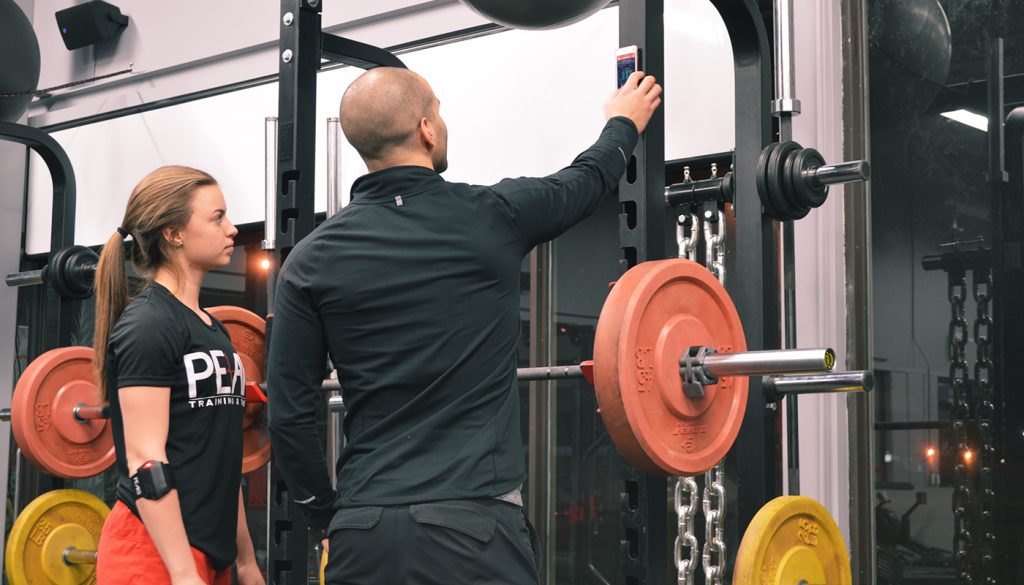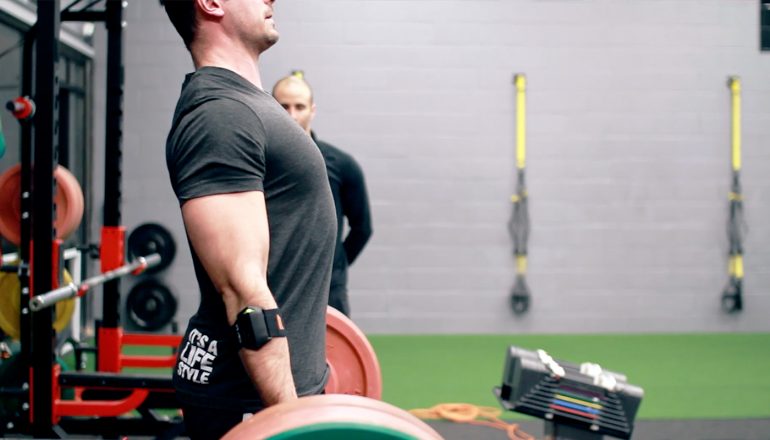In the future, you’ll not only pack a pair of shorts, a tank, and running shoes to hit the gym, but a bunch of sensors, too. For Mississauga-based PEAKS Training and Therapy, that future is now. The strength conditioning facility uses wearable tech with 100% of its clients to take training to the next level with data.
In December, PEAKS did away with paper-based logging and Excel charts, still the standard in personal training for most gyms. In its place, it adopted the use of wearables and apps to measure client performance. “We were using Excel charts and having things auto-populate in Excel, and it was tedious and time-consuming,” PEAKS co-owner Adrian Wellman told BetaKit. “It was not as streamlined and easy to use as we would have liked.
“If you have a human being there you have to answer to them, you don’t have to answer to an app.”
“Then we started to use Google Drive to have clients log things like reps and weights, but again it was just not user-friendly and it was a lot to ask of the client. So that’s when we started to search for a platform that could replace this.”
PEAKS currently uses two wearables that allow it to do away with manual logging, empowering its clients and trainers with robust data, both historical and real-time. All PEAKS clients are given a Polar chest strap to monitor heart rate and a PUSH band to track strength training performance while working out such as reps and workload. Right now, trainers look to both the PUSH and Polar apps for client data. The PUSH app does support heart rate monitoring, but according to Wellman it doesn’t record the data. Wellman told us that when the PUSH app is updated with heart rate recording functionality they will move to use the PUSH app as the sole system for the gym.

With connected clients, PEAKS’ trainers are able to root their coaching in both their experience and the available real-time data being collected during a workout. During a warm-up, trainers monitor their client’s heart rate via the Polar app to make sure that they are in the right aerobic heart rate zone. During strength training, the data collected in the PUSH app is used as a key input to help determine adjustments in weight and speed for the next set. Using data removes the subjectivity in training. “Rather than us just judging based on facial expressions and sweat, we actually know how hard their bodies are working and what they are outputting,” explained Wellman.
“Rather than us just judging based on facial expressions and sweat, we actually know how hard their bodies are working and what they are outputting.”
But Wellman is quick to point out that real-time data shouldn’t become a distraction when working out. “We don’t want to be too focused on the data,” he said. “It’s extra information. At the end of the day, it’s about working hard, working smart, and the quality of the movement – the numbers are a supplement to that. We can’t have tunnel vision. Wearables are great, but when you start to lose sight of grit and hard work and just focus on the numbers, that’s when you start to lose progress.”
Wellman indicated that the real benefit of the data lies in being able to access his clients’ data over time, using that during regular performance reviews to gauge how well they are doing and provide recommendations on how to improve. “I like the fact that we can go back in the PUSH app and look at the data versus having a notebook, where all you could do is flip back to the time you did the same workout and see if you increased weight or decrease weight,” he said.
As data doesn’t lie, Wellman explained that another benefit to using wearables in training is an increased accountability both for the client and for the trainer. The client works harder and more in-line with the training program because they know their activity is being monitored. “If it’s on paper they can write down they did an extra set even if they didn’t,” he said. “In the app they know that we can see the reps, the speed, and the rest period, which adds an accountability factor.” For the trainer, this data is evidence as to whether their choices in training are working or not. “There is more pressure on us as the data makes things very objective,” he explained. “It also gives us a little more confidence in the coaching and the feedback that we give.”
Despite how smart these devices are, Wellman isn’t too worried that wearables will remove the need for a trainer. “I think wearables give you more information and definitely empowers people, but at the end of the day, understanding what exercise works best, how the individual feels, and their technique, requires a human element that can’t be replaced,” he said. And although data can help make clients more accountable, Wellman believes that the real accountability comes from not disappointing a human trainer. “If you have a human being there you have to answer to them, you don’t have to answer to an app.”

